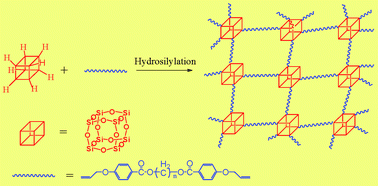Design and architecture of low-dielectric-constant organic–inorganic hybrids from octahydridosilsesquioxanes
Abstract
Molecular design and architecture of four novel organic–inorganic network hybrids were implemented via hydrosilylative

Maintenance work is planned for Wednesday 1st May 2024 from 9:00am to 11:00am (BST).
During this time, the performance of our website may be affected - searches may run slowly and some pages may be temporarily unavailable. If this happens, please try refreshing your web browser or try waiting two to three minutes before trying again.
We apologise for any inconvenience this might cause and thank you for your patience.
* Corresponding authors
a
College of Material Science and Engineering & State Key Laboratory for Modification of Chemical Fibers and Polymeric Materials, Donghua University, Shanghai 201620, China
E-mail:
hongyaoxu@163.com
Fax: +86-21-67792874
Tel: +86-21-67792874
b Department of Chemistry and Material Engineering, Hefei University, Hefei, Anhui 230022, China
c State Key Laboratory of Polymer Physics and Chemistry, Institute of Chemistry, Chinese Academy of Sciences, Beijing 100190, China
d Department of Physics, National University of Singapore 117542, Singapore
Molecular design and architecture of four novel organic–inorganic network hybrids were implemented via hydrosilylative

 Please wait while we load your content...
Something went wrong. Try again?
Please wait while we load your content...
Something went wrong. Try again?
B. Yang, H. Xu, Z. Yang and X. Liu, J. Mater. Chem., 2009, 19, 9038 DOI: 10.1039/B915872C
To request permission to reproduce material from this article, please go to the Copyright Clearance Center request page.
If you are an author contributing to an RSC publication, you do not need to request permission provided correct acknowledgement is given.
If you are the author of this article, you do not need to request permission to reproduce figures and diagrams provided correct acknowledgement is given. If you want to reproduce the whole article in a third-party publication (excluding your thesis/dissertation for which permission is not required) please go to the Copyright Clearance Center request page.
Read more about how to correctly acknowledge RSC content.
 Fetching data from CrossRef.
Fetching data from CrossRef.
This may take some time to load.
Loading related content
